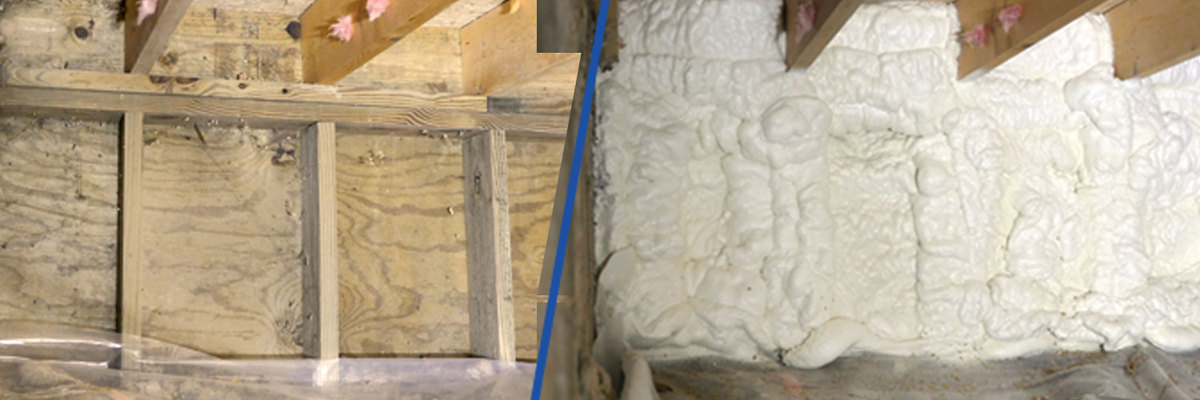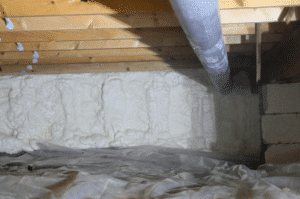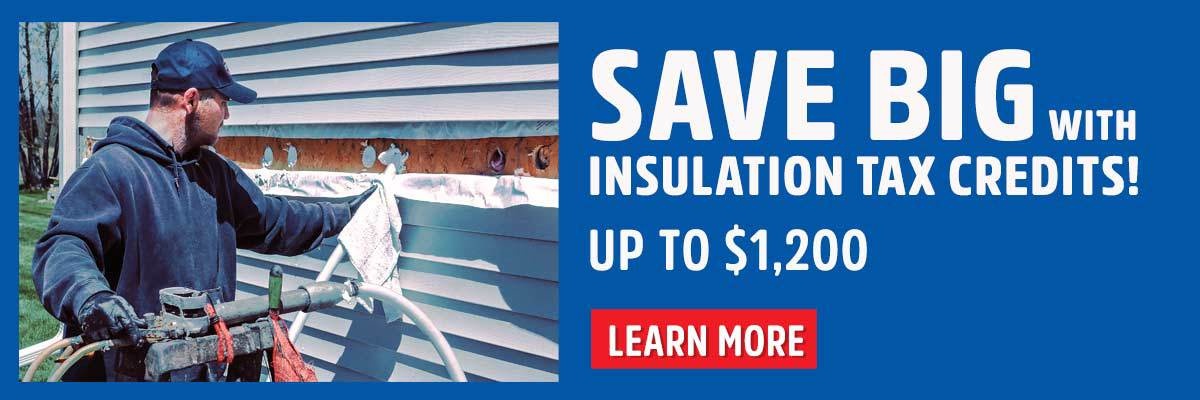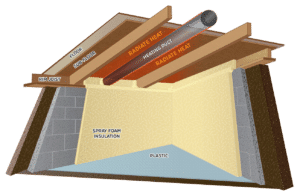How Much Does Insulating a Crawl Space with Spray Foam Cost in 2026? (Prices/Rates/Factors)


Cold feet and high energy bills giving you the winter blues? There is a quick fix that can relieve your frozen toes and save you money in the long run.
With more than 20 years of experience insulating thousands of crawl spaces, RetroFoam of Michigan knows that installing spray foam insulation under the house can improve the comfort of your existing home.
Let's jump right in and discuss how much spray foam crawl space insulation costs, what factors determine the final cost, and what services are included.
Key Points:
• Crawl space insulation costs typically range between $2,000 and $3,400 depending ont he size and setup of the space.
• Factors that affect price include the crawl space size, wall height, insulation type (open cell vs. closed cell), and whether old insulation needs to be removed.
• Cold floors, high energy bills, and freezing pipes are the most common signs that your crawl space needs insulation.
• Insulating crawl space walls is ideal when ductwork or a furnace is present, while insulating the underside of the floor works better if there's no heat source below.
• Spray foam insulation creates an air seal that helps eliminate drafts, lowers energy bills, and improves comfort year-round.
• Added services from RetroFoam of Michigan include free estimates, a dedicated concierge, cleanup, financing assistance, and rebate application.
• Rebates can reduce your total insulation costs depending on your utility provider.
• RetroFoam of Michigan serves the Lower Peninsula and greater Toledo area, offering expert crawl space insulation backed by more than 20 years of experience.
How Much Does it Cost to Insulate a Crawl Space?
Not every crawl space is the same size, so the area to be insulated is the main contributor to the cost of the spray foam insulation project.
The average cost to insulate a crawl space with spray foam is between $2,000 and $3,100.
What Factors Determine the Crawl Space Insulation Cost?
The biggest factor in the cost to insulate or re-insulate a crawl space is always the area's size.
If crews are insulating the underside of the house floor or the crawl space walls and rim joists, there is a world of difference between those two applications. That’s because there is so much more area to cover when insulating the underside of the floor and rim joist compared to the crawl space walls and rim joist.
The height of the walls in the crawl space can also increase costs. The average height of the crawl space walls is between 1 and 3 feet, but they can be taller. The higher the walls are, the more costly it will be.
If crews are laying down plastic to create a vapor barrier, there are also additional charges for this as well.
Another factor in cost is the material used to insulate the crawl space. We usually recommend an open cell spray foam, but there are circumstances when closed cell foam is a better option. Closed cell tends to be a more expensive product.
There are several differences between open cell and closed cell spray insulation, including composition, blowing agent, sound dampening capabilities, and moisture permeability. Spray foam insulation, regardless of the type, is going to create an air seal and insulate your crawl space.
Finally, when determining the cost of insulating your crawl space, the removal of the old insulation can also be factored in. The old insulation in the crawl space must be removed before spray foam can be installed. This removal comes with some extra cost, but also helps the homeowner avoid the headache of removing the insulation themselves and finding a place to dispose of it.
What are the Indicators that the Crawl Space Needs New Insulation?
Cold floors in your home are the most common indicator that you need to add under-house insulation in the crawl space.
That’s because the air in the crawl space is cold. When a bridge freezes over faster than a road, it’s because it has cold air above it and below it.
The same concept works in your house. When there is air movement on top of the floor, and the crawl space isn’t sealed up, then the cold air below the floor moves throughout your home. You could also feel those cold drafts coming up around the bottom of your walls.
Cold floors can lead to high energy bills, and the cold air in your crawl space is also to blame for freezing pipes.
In Michigan, many homes have ductwork that runs throughout the crawl space, so if cold air is flowing around those ducts, the hot air in them will cool down before it ever reaches the vent in your bedroom or living room.
What are the Benefits of Insulating the Crawl Space?
- Floors are no longer cold.
- No more drafts along baseboards.
- Lower energy bills.
- Prevents pipes that run through the crawl space from freezing and bursting.
Insulating Crawl Space Walls Versus the Underside of the Floor
In crawl spaces, there are two ways to add spray foam insulation under a house: crews can insulate the crawl space walls or the underside of the house floor.
What determines which area to insulate depends on whether there is ductwork or a furnace in the crawl space.
If there are heat ducts in the crawl space, a good contractor will want to spray the exterior walls and lay plastic on the ground. This system will help the heat ducts radiate heat in the crawl space, which will heat it, thus also heating the floor.
Insulating the underside of the floor is a better option if there are no ducts in the crawl space. Since there is no heat source, this will cut the crawl space off from the rest of the house, keeping it warmer. Essentially, you won’t be getting that cooler air coming up through the crawl space.
What is the Process for the Installation of Spray Foam in the Crawl Space?
 On the first day of the job, crews will come to the home and remove any existing insulation in the crawl space.
On the first day of the job, crews will come to the home and remove any existing insulation in the crawl space.
The older insulation must be removed in order for the spray insulation to do its job.
The next step is to lay down plastic if the crawl space walls are being insulated. The plastic covers the entire floor, and if there are support beams, the plastic will overlap around them so moisture can’t get through. The plastic is then rolled up the walls about a foot or so, and then the foam is sprayed on, creating a seal.
If only the underside of the floor is to be insulated, then no plastic needs to be laid down, and crews will spray foam on the underside of the floor.
Once the foam has been sprayed, crews will work to clean up the area and make sure it looks just like it did before the job began.
Services that Should Be Included When Insulating a Crawl Space
The best insulation companies should offer services that start with the call for an estimate and end with you living in a more comfortable home.
Some of the services that should be included are:
- A free estimate for the project.
- Free concierge program so someone stays with you throughout the entire project to answer any questions you may have.
- Help with applying for financing for the project
- Crews clean out old insulation from the crawl space and dispose of it properly.
- Crews clean up after the project is complete, so your home looks just as it did before the job was started.
- Your concierge is applying for rebates, so you get money back on your project from your energy provider.
- A lifetime warranty that is connected to the house.
Added Protection Against Drafts and High Energy Bills
Sometimes, cold air moving through a crawl space or attic can contribute to the discomfort you are feeling in your home, but sometimes, there is more to the discomfort you are feeling.
Insulating your entire home using injection foam and spray foam can make a difference year-round, keeping you cool in the summer and warm in the winter and saving you money on your energy bills.
This is because the foam insulation creates an air barrier that completely seals the building envelope.
Fees and Taxes in Addition to Spray Foam Insulation Crawl Space Cost
An experienced and trustworthy contractor won’t hit you with hidden fees and costs after the job is done.
The estimate you agree to and sign should be the project's final cost.
Unlock Savings with Foam Insulation Rebates and Tax Credits in Michigan
Did you know there are amazing opportunities to save big when choosing foam insulation for your home?
Let's break it down: Rebates and tax credits might sound similar, but they're different in their essence.
Rebates are like rewards for achieving specific energy-efficient goals, while tax credits are amounts that can offset your tax liability. And guess what? Both are up for grabs when you opt for energy-efficient upgrades like foam insulation.
There are various forms of rebates and tax credits waiting for you. If you're insulating a single area of your home, you can snag a rebate ranging from $50 to $250, courtesy of utility providers like Consumers Energy, DTE, SEMCO, and Michigan Gas and Utilities.
But wait, there's more. If you insulate at least two areas of your home, the home performance rebate kicks in, offering you a boost ranging from $400 to $1,100.
Thanks to the Inflation Reduction Act, you can claim up to $1,200 in tax credits annually for insulation or other energy-efficient upgrades until December 31, 2025. Plus, an additional $150 credit is available for home energy audits. To get your hands on these savings, all you need to do is complete IRS Form 5695 and provide a copy of your contract with RetroFoam of Michigan.
Here's the crucial bit: To ensure you're eligible for these fantastic deals, consult your energy provider and a tax professional. They'll guide you through the process and ensure your hard work qualifies.
By leveraging these rebates and tax credits, the cost of foam insulation for your home in 2024 could be significantly reduced. It's not just about saving money; it's about making your home energy-efficient and environmentally friendly.
Getting Started with Spray Foam in Your Crawl Space
If you are located in greater Toledo or Michigan's Lower Peninsula and ready to schedule a free in-home estimate, give us a call at 866-900-3626 or fill out the form on our website.
You can also check out our foam insulation budget calculator to give you a rough idea of the cost of the project.
Related Articles
Does My Dirt Floor Crawl Space Need a Vapor Barrier?
Best Way to Insulate Crawl Space with Spray Foam: Walls or Ceiling?
What is the Best Crawl Space Insulation? (Spray Foam vs Fiberglass)
FAQs About Crawl Space Insulation Cost
How much does it cost to insulate a crawl space with spray foam?
On average, homeowners spend between $2,000 and $3,400. The price depends on crawl space size, insulation type, and prep work like removing old insulation.
What's the difference between insulating the crawl space walls and the underside of the floor?
If your crawl space has heat ducts or a furnace, insulating the walls helps keep the space warm.
If it doesn't, insulating the underside of the floor separates it from cold air and keeps your floors warmer.
What are the biggest benefits of spray foam insulation in a crawl space?
You'll notice warmer floors, fewer drafts, lower energy bills, and protection against frozen pipes.
Spray foam also improves your home's overall comfort and efficiency.
How do I know if my crawl space needs new insulation?
Cold floors, drafts along baseboards, and high heating bills are telltale signs.
Frozen pipes or uneven room temperatures can also indicate poor crawl space insulation.
Can I get rebates from my utility provider for insulating my crawl space?
Yes! Michigan homeowners may qualify for utility rebates up to $1,100, depending on the provider.
Check with your utility company for eligibility.
What does the crawl space insulation process include?
The crew will remove old insulation, lay down vapor barrier plastic (if needed), and spray foam insulation on the designated areas.
After installation, the space is cleaned up to look as it did before.
Does RetroFoam of Michigan offer any guarantees?
Yes -- every project includes a lifetime warranty tied to your home, ensuring long-term peace of mind.
Save
About Amanda Emery
Amanda previously has worked as a breaking news and crime reporter, TV news producer, and editor in Flint and Detroit. Throughout her career as a journalist, she has won several awards from The Society of Professional Journalists - Detroit Chapter and the Michigan Press Association. As part of the RetroFoam of Michigan family, Amanda uses her experience as a journalist to write content that will help educate homeowners on the benefits of foam insulation. When Amanda isn’t writing, she’s spending time with her husband and rescued huskies. She also loves knitting, making art, cooking, and hosting dinner and a movie night for friends and family.





